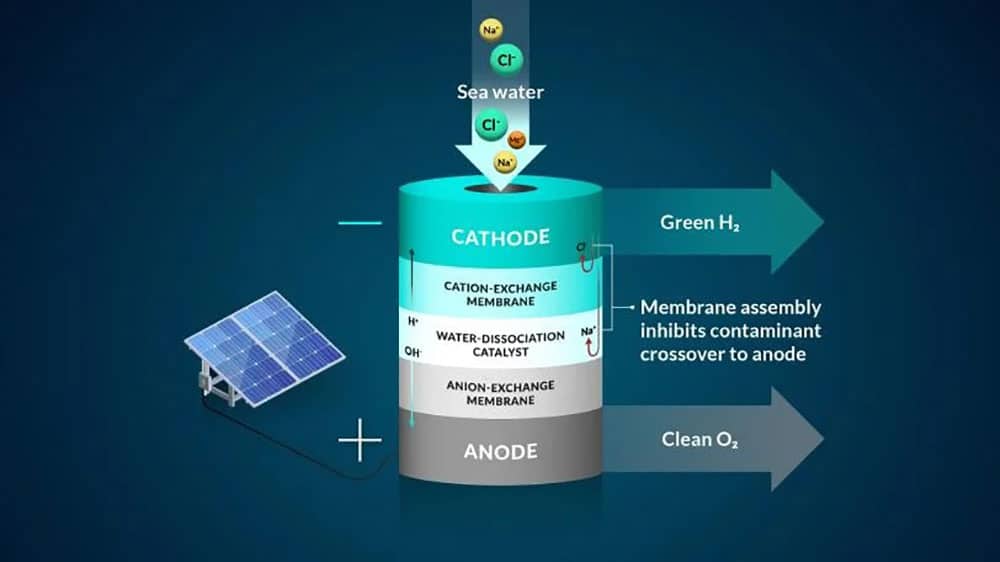Hydrogen is an appealing option for fuel because it doesn’t emit carbon dioxide. Many attempts to make hydrogen gas start with fresh or desalinated water, but those methods can be expensive and energy intensive. Seawater is a complex mixture of hydrogen, oxygen, sodium, and other elements, which makes it difficult to extract hydrogen gas for clean energy uses.
Now, researchers have found a way to extract hydrogen out of the ocean by funneling seawater through a double-membrane system and electricity.
Developed by researchers from the Department of Energy’s SLAC National Accelerator Laboratory and Stanford University with collaborators at the University of Oregon and Manchester Metropolitan University, the innovative design proved successful in generating hydrogen gas without producing large amounts of harmful byproducts.
The team implemented a bipolar, or two-layer, membrane system and tested it using electrolysis, a method that uses electricity to drive ions, or charged elements, to run a desired reaction. They started their design by controlling chloride, the most harmful element to the seawater system.
“There are many reactive species in seawater that can interfere with the water-to-hydrogen reaction, and the sodium chloride that makes seawater salty is one of the main culprits,” said Joseph Perryman, a SLAC and Stanford postdoctoral researcher. “In particular, chloride that gets to the anode and oxidizes will reduce the lifetime of an electrolysis system and can actually become unsafe due to the toxic nature of the oxidation products that include molecular chlorine and bleach.”
The bipolar membrane in the experiment allows access to the conditions needed to make hydrogen gas and mitigates chloride from getting to the reaction center.
In their experiments, protons, the positive hydrogen ions, passed through one of the membrane layers to a place where they could be collected and turned into hydrogen gas by interacting with the cathode, a negatively charged electrode. The second membrane in the system allowed only negative ions, such as chloride, to travel through.

As an additional backstop, one membrane layer contained negatively charged groups that were fixed to the membrane. This made it harder for other negatively charged ions, like chloride, to move to places where they shouldn’t be, the researchers say. The negatively charged membrane was found to be highly efficient in blocking almost all of the chloride ions in the team’s experiments. Also, their system operated without generating toxic byproducts like bleach and chlorine.
“There is also some interest in using electrolysis to produce oxygen,” said Daniela Marin, a Stanford graduate student in chemical engineering and co-author. “Understanding ion flow and conversion in our bipolar membrane system is critical for this effort, too. Along with producing hydrogen in our experiment, we also showed how to use the bipolar membrane to generate oxygen gas.”
In future work, researchers plan to improve their electrodes and membranes by building them with more abundant and easily mined materials. This improvement in the design could make the electrolysis system easier to scale to a size needed to generate hydrogen for energy-intensive activities, like the transportation sector, the team said.
“The future is bright for green hydrogen technologies,” said Thomas Jaramillo, professor at SLAC and Stanford and director of SUNCAT. “The fundamental insights we are gaining are key to informing future innovations for improved performance, durability, and scalability of this technology.”
Journal reference:
- Daniela H. Marin, Joseph T. Perryman, McKenzie A. Hubert, Grace A. Lindquist, Lihaokun Chen, Ashton M. Aleman, Gaurav A. Kamat, Valerie A. Niemann, Michaela Burke Stevens, Yagya N. Regmi, Shannon W. Boettcher, Adam C. Nielander, Thomas F. Jaramillo. Hydrogen production with seawater-resilient bipolar membrane electrolyzers. Joule, 2023; DOI: 10.1016/j.joule.2023.03.005
New system pulls hydrogen directly from seawater
Source: Tambay News

0 Comments